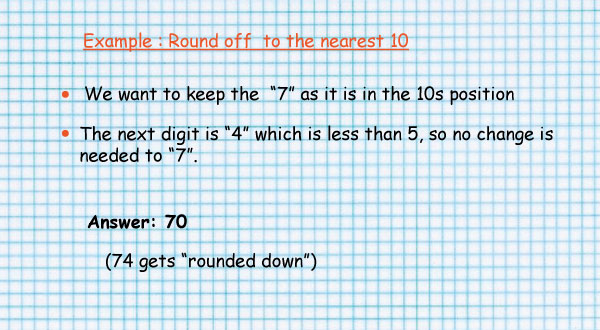Rounding means reducing the digits in a number while trying to keep its value similar.
A rounded number has about the same value as the number you start with, but it is less exact.

For example, 341 rounded to the nearest hundred is 300. That is because 341 is closer in value to 300 than to 400. When rounding off to the nearest Kenyan Shilling, Kshs.1.89 becomes Kshs.2.00, because Kshs.1.89 is closer to Kshs.2.00 than to Kshs.1.00
The result is less accurate, but easier to use.
Example: 73 rounded to the nearest ten is 70, because 73 is closer to 70 than to 80.
How to Round Numbers
Here's the general rule for rounding:

So: when the first digit removed is 5 or more, increase the last digit remaining by 1.
5 is in the middle ... so we could go up or down. But we need a method that everyone agrees to.
So think about sport: you should have the same number of players on each team, right?
And that is the "common" method of rounding
First you need to know if you are rounding to tenths, or hundredths, etc.
Or maybe to "so many decimal places".
That tells you how much of the number will be left when you finish.

You may want to round to tens,hundreds,etc,in this case you replace the removed digits with a zero.

Round off 67 to the nearest ten.
67 lies between two groups of ten, i.e. 60 and 70.
On a number line, 67 is close to 70 than it is to 60
Example 2
Round off 144 to the nearest hundred.
144 lies between two groups of hundreds which are 100 and 200.
On a number line,144 is close to 100 than it is to 200
Round off 15642 to the nearest
Therefore, 15642 to the nearest thousand is 16000.
Play this video and learn more on how to round off Decimals
Play this video and learn more on how to round off Whole numbers
In mathematics, rounding off is really exciting.
In mathematics rounding off is writting an answer to a given degree of accuracy.
Let's round off 314 to the nearest hundred.
You know that 314 is closer to 300 than 400, so when rounded off 314 to the nearest hundred is 300.
Now let's round off 483 to the nearest hundred.
We know that 483 is in between 400 and 500 and it is closer to 500. So, 483 rounded off to the nearest hundred is 500.
This is another way of looking at it:
In 483, 4 is in Hundred Place
8 is in Tens Place
3 is in Units Place
| Hundreds | Tens | Units/Ones |
| 4 | 8 | 3 |
We want to round off 483 to the nearest hundred. The number to the right of 4 is 8, which is more than 5. So you add 1 to the 4 ie 5 and change the digits in tens and units to zeros.
4/83 (8 is more than 5 so we add 1 to 4)
4/83 = 500 (means it is approximately equal to)
| Hundreds | Tens | Units/Ones |
| 4 | 8 | 3 |
In this number 8 represents tens. The number to the right of 8 is 3 which is less than 5, so we round down the number.
There are several things you need to do in order to round a number. First, locate the digit you are rounding. Let’s say it’s the hundreds digit.
See the image below

Solution:
53 is situated between 50 and 60. The middle number between 50 and 60 is 55.
53 is before 55, so it is rounded down to 50.

(When any number is situated half way or in the middle of two convenient whole numbers, it is rounded up to the higher whole number)
55 is rounded up to 60, 75 is rounded up to 80
54 is rounded down to 50, 74 is rounded down to 70